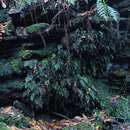Biology
provided by Arkive
Uniquely, Killarney fern occurs in two forms in the UK. One is called a gametophyte, is more common, and is the sexual form of the plant. This is perennial, capable of spreading vegetatively, and found in dark caves or crevices. It was only discovered in the UK in 1989. The other form is called a sporophyte, is much rarer, and is the ferny form of the plant.
Conservation
provided by Arkive
Discovery of the differing forms of the plant has lead to an increased interest in the Killarney fern. It is listed in the UK Biodiversity Action Plans (UKBAPs), and included in English Nature's Species Recovery Programme (SRP).
Surveys across the country have revealed new sites of the fern, and genetic research has enabled more effective conservation measures. Although the sporophytes are still rare, there are fewer fears now about the future survival of the Killarney fern. However, it could still fall prey to collectors, and the fern is strictly protected by law.
Description
provided by Arkive
This distinctive fern is one of three European species with translucent (semi-transparent) leaves. There can be as many as several hundred leaves, growing from the creeping root, depending on the size of the plant colony. The Killarney fern was only discovered in 1724.
Habitat
provided by Arkive
Killarney fern requires a humid, frost-free environment, and in Britain, is restricted to shady, sheltered ravines with waterfalls, or places with similar conditions.
Range
provided by Arkive
This fern is found mainly in Ireland, Brittany (north-western France), the Canaries, Madeira and the Azores. In Britain it is found in two stages, one of which is rare and found from a few sites in the west of the country. The other, more numerous stage, is widely scattered, but more common in the west.
Status
provided by Arkive
Classified as Vulnerable in the UK. Protected under Schedule 8 of the Wildlife and Countryside Act (as amended). Listed unded Annexes II and IV of the Habitats Directive, and Appendix 1 of the Bern Convention.
Threats
provided by Arkive
During the Victorian period in the UK, there was a craze for collecting ferns from the wild, in order to grow them for ornamental purposes. It is likely that the rare Killarney fern was over-collected, and has not been able to recover its populations back to former numbers.
Today, there may be further threats from eager collectors and photographers, and activities which alter the humidity and the water quality of the sites.
Associations
provided by BioImages, the virtual fieldguide, UK
In Great Britain and/or Ireland:
Foodplant / saprobe
scattered hysterothecium of Gloniella adianti is saprobic on faded frond of Trichomanes speciosum

